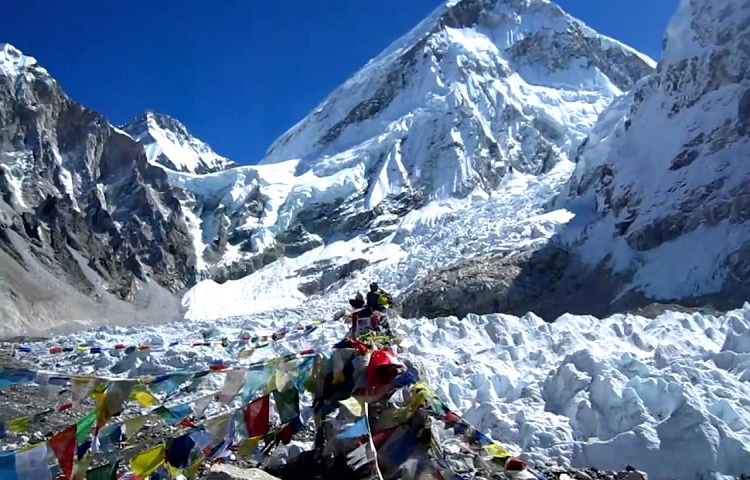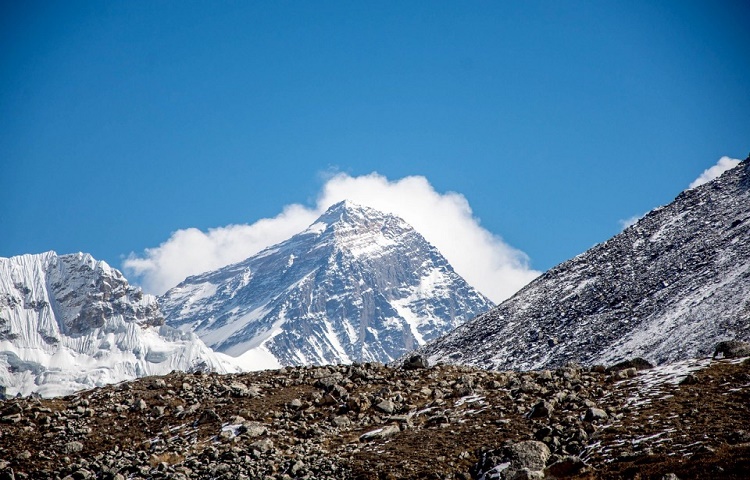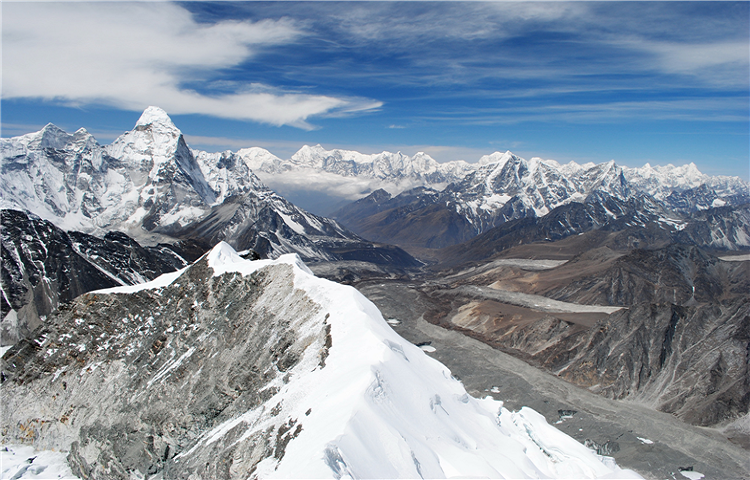- Overview
- Itinerary in Details
- Reviews
Trip Overview
Everest Panorama Trek
The Everest Panorama Trekking route is a popular destination for those looking experience the stunning beauty of the Himalayan Mountains. This trek offers breathtaking views of some of the world’s tallest peaks, including Mountain Everest, Lhotse, Nuptse, and AmaDablam.
One of the great things about this trek is that it is considered to be relatively easy compared to other trekking routes. This makes it a great option for individuals with varying fitness level, as well as for families and groups with different experience levels.
The trek begins with a flight to Lukla, a small town in the Khumbu region of Nepal. From there, trekkers will make their way to Namche Bazaar (a bustling market town and the gateway to the Everest region. Along the way trekkers will pass through picturesque Sherpa villages, beautiful forests, and stunning scenery.
While the trek is relatively easy, there are some key factors to consider before embarking on this adventure. Altitude sickness can be a serious concern, as the trek takes you to high elevations. It’s important to acclimatize properly, stay hydrated, and listen to your body to avoid any altitude-related issues. Additionally, the weather in the Himalayas can be unpredictable, so it’s important to pack the right gear and be prepared for changing conditions. It’s important to be in a good physical condition before embarking on the trek.
Overall, the Everest Panorama Trekking route is a stunning adventure that offers breathtaking views of the Himalayas. With a little preparation and the right mindset, it’s an experience that will stay with you for a lifetime.
The Highlights of the Everest Panorama trekking.
Certainly, The Everest Panorama Trekking route is a spectacular adventure that offers a range of highlights and memorable experiences. Some of the main highlights of the trek are below:
- Stunning Mountain Views:
The Everest Panorama Trekking route is renowned for its breathtaking views of the world’s tallest mountains, including Mount Everest, Lhotse, Nuptse, and AmaDablam. The highlight of the trek is undoubtedly the panoramic views of these stunning peaks from famous viewpoint at Tengboche Monastery. The views are truly awe-inspiring and will lasting memories.
- Unique cultural experiences:
The Everest region is home to the Sherpa people, who are renowned for the hospitality and warmth. Trekking through the region offers a chance to experience their unique culture, traditions, and way of life. You’ll have the opportunity to visit traditional Sherpa villages, interact with locals and learn about their customs and beliefs.
- Beautiful forests and landscapes:
The trek takes you through the range of the stunning landscapes, from the huge forest of rhododendron and oak trees to high altitude valleys and meadows. The scenery is truly wonderful and provides a wonderful backdrop for the trek.
- Namche Bazaar:
Namche Bazaar is a bustling market town and the gateway to the Everest region. It’s a vibrant and lively place that offers a range of amenities and services for trekkers. The town I situated in a beautiful location, surrounded by stunning mountain scenery.
- Tengboche Monastery:
Tengboche Monastery is one of the most famous and important monasteries in the region. It’s situated at an elevation of 3,867 meters and offers stunning views of the Himalayas. The monastery is renowned for the beautiful architecture, intricate wall paintings, and spiritual significance.
- Sagarmatha National Park:
The Everest Panorama Trekking route passes through the Sagarmatha National Park, which is home to wide range of flora and fauna. The park is a UNESCO World Heritage Site and offers a chance to see rare and endangered species, such as the snow leopard and red panda.
- High altitude trekking:
The trek takes you to high elevations, with the highest point at Tengboche Monastery at 3,867 meters. Trekking at high altitude can be challenging but also offers a unique and rewarding experience.
Best seasons for Everest panorama trek:
The Everest Panorama Trekking is the popular trekking destination in the Himalayas of Nepal. The best seasons for this trek are from February to the end of April and from September to the end of December.
February to the end of April:
This period is the spring in Nepal, and it is one of the best times to trek to Everest Panorama. The weather during this time is clear and dry, with stable temperatures, making it easier for trekkers to enjoy the views and complete the trek without any major hindrances. During this time, the rhododendron flowers bloom, and the hills are covered with a colorful blanket of flowers. This creates a beautiful landscape, and the clear skies offer excellent views of the mountains.
September to the end of December:
This period is the autumn season in Nepal and is another great time Everest Panorama Trekking. The weather at this time is dry and clear, with stable temperatures. This time of year is known for its stunning views of the mountains, and the trekking trials are less excellent views of mountains, and the challenging colors of the leaves on the trees create a beautiful landscapes.
Overall both the spring and autumn seasons offer great weather conditions for the Everest Panorama Trekking. However, proper gear and equipment are essential to ensure a safe and enjoyable trekking experience.
List of equipment needed:
- Trekking boots: A good pair of trekking boots is essential. Make sure they are comfortable, waterproof, and have a good ankle support.
- Backpack: You’ll need a sturdy backpack to carry your gears, water, and snacks during the trek.
- Warm clothing: The temperature can be quite cold during the trek, so it is essential to have warm clothing, such as down jacket, thermal pants and shirts, fleece jackets and gloves.
- Trekking pants: It’s important to have comfortable and durable trekking pants that are quick- drying and moisture-wicking.
- Sun protection: The sun can be intense at high altitudes, so it’s essential to have sunglasses, sunscreen, and a hat.
- Water bottles: You’ll need to stay hydrated during the trek, so it is important to carry water bottles or hydration system.
- Headlamp or flashlight: You may need to trek in the dark, so a headlamp or flashlight is essential.
- Trekking poles: trekking poles can help you balance and reduce the strain on your legs during the trek.
- First aid kit: It’s always a good idea to keep first aid kit with you, including medicines for altitude sickness, pain relief, and wound care.
- Sleeping bag: You will need a warm and comfortable sleeping bag for the night spent in teahouses during the trek.
How difficult is Everest Panorama Trekking ?
The Everest Panorama Trek is considered to be a moderately challenging trek in the perspective of most travellers. Compared to the Everest Base Camp Trek, the Panorama Trek is not as difficult, but it still requires a moderate level of physical fitness and endurance. It is a good option for families with children who are looking for an adventure and want to experience the beauty of the Himalayas.
The trek usually takes around 5 to 7 days and covers a distance of approximately 35 kilometers, with an average altitude of 3,500 meters. The trek involves walking on uneven terrain, rocky paths, and uphill sections, but the pace is generally relaxed, allowing trekkers to acclimatize to the altitude and enjoy the stunning panoramic views of Everest and other peaks in the region.
Overall, the Everest Panorama Trek is a great option for those looking for a less tough alternative to the Everest Base Camp Trek, while still experiencing the beauty of the region and the culture of the Sherpa people. It is important to note that proper preparation, including physical fitness training and proper gear, is necessary for a safe and enjoyable trek.
Why should you prefer Family Adventure trek for Everest panorama trekking.
Choosing Family Adventure trek for Everest Panorama Trekking is a great choice for both families and teams who want to experience the trek in a safe and enjoyable way.
- Professional guides:
Family Adventure Treks are led by experienced and professional guides who are trained to work with children. They are knowledgeable about the trek and the local culture, and they are skilled in managing any issues that may arise during the trek. They are also fluent in English, which makes communication easy.
- Time punctual:
Family Adventure is designed to cater to families with children, so the itinerary is flexible and takes into account the children’s needs. We provide a time punctual schedule that allows for ample rest breaks and exploration time. The trek also includes a few extra days to acclimatize, which is important for helps in minimizing the risk of altitude sickness.
- Quality equipment:
Family Adventure trek provides quality equipment and gear to ensure the safety and comfort of the trekkers. The agency uses high- quality camping gear, trekking poles, sleeping bags, and other equipment to make the trek comfortable and enjoyable.
- Tailor-made itinerary:
Family Adventure can tailor the itinerary to meet the specific needs and interests of your family. We can provide special activities for the children, and can customize the itinerary to allow for more exploration time or rest breaks.
- Local experience:
Family Adventure can arrange the local experience, allowing you to interact with locals and learn about the local culture and customs. The agency can arrange for culture experiences, such as cultural dances and local cuisine, to give your team or family a deeper appreciation of the local culture.
Brief Itinerary
Day 01: Arrival in Kathmandu
Day 02: Sightseeing of Kathmandu and Bhaktapur city
Day 03: Fly to Lukla and trek to Phakding (2,652m/8,700ft) 30 minutes flight and 4 hours walk
Day 04: Trek to Namche Bazaar (3440m/11,283ft) 5-6 hours walk
Day 05: Acclimatize at Namche
Day 06: Trek to Tengboche (3,867m/12684ft) 5 hours walk
Day 07: Wandering around Tengboche and return to Namche.
Day 08: Trek to Lukla (2,652m/8,700ft)
Day 09: Fly to Kathmandu
Day 10:Transfer to the airport for the final departure
Cost Includes
- Airport pickups and drops in a private vehicle
- 3-star hotel accommodation in Kathmandu with breakfast
- Teahouse accommodation during the trek
- Tented accommodation during the climb
- All meals (breakfast, lunch and dinner) during the trek and climb
- Welcome and farewell dinners
- All ground transportation on a comfortable private vehicle as per the itinerary
- English speaking, trained and experienced trekking guide (leader), climbing guide (leader) and assistant guides
- Porter service
- Staff costs including their salary, insurance, equipment, domestic airfare, food and accommodation
- Down jacket (to be returned after trip completion)
- Leaf holidays trekking bag
- All necessary paperwork; trekking permits
- Good quality tents and kitchen utensils for camping
- Medical kit (carried by your guide)
- All government and local taxes
Cost Excludes
- Nepalese visa fee
- Excess baggage charge(s)
- Extra night accommodation in Kathmandu because of early arrival, late departure
- Emergency expenses like rescues, emergency medical treatment.
- Personal insurance charges.
- International flights
- Travel and rescue insurance
- Personal expenses (phone calls, laundry, bar bills, battery recharge, extra porters, bottle or boiled water, shower, etc.)
- Tips for guide(s), porter(s) and driver(s)
Trip in Details
Review Form
Best Selling Holidays
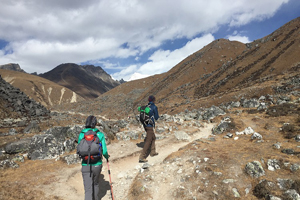
Luxury Everest Base Camp Trek
12 Days

Kailash Tour via Lhasa
15 Days
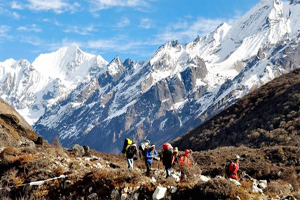
Langtang Gosainkunda Trek
16 Days
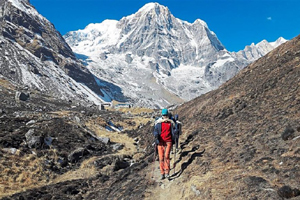
Annapurna Base Camp Trek
12 Days
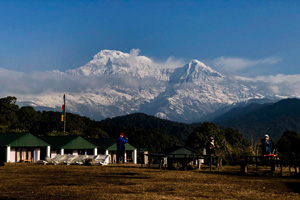
Mardi Himal Trek
15 Days

